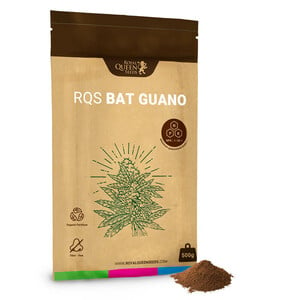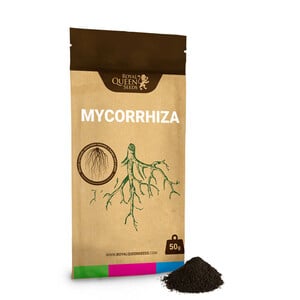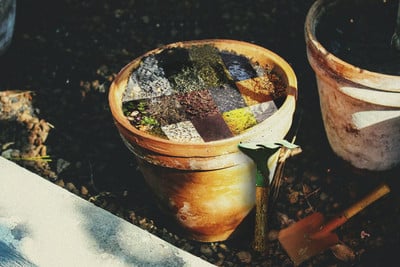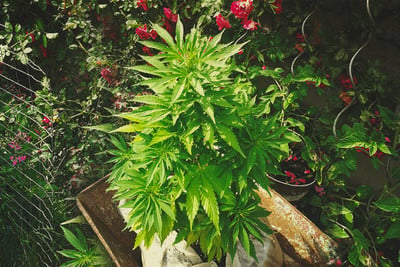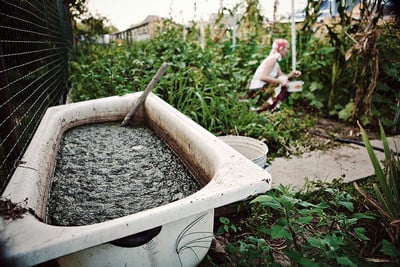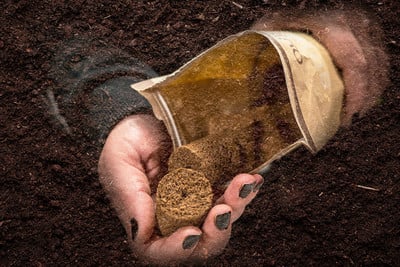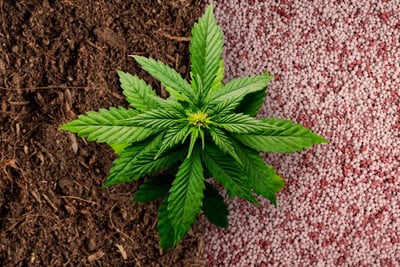.

Top Dress Your Weed Plants To Feed Your Soil
Synthetic fertilisers are convenient, but they leave the soil depleted in the long-run. Top dressing is a regenerative method of feeding plants that restores soil health and promotes the growth of beneficial microorganisms.
Contents:
There’s more than one way to feed a cannabis plant. Synthetic nutrients provide an instant solution to nutritional deficiencies, however, they don’t do much for the health of the soil[1]. In contrast, organic nutrients provide the complete package, feeding plants and the soil in kind. Top dressing is a technique that involves applying organic nutrients to the surface of the soil. Many cultivators have improved the health of their crops using this simple yet effective method.
Importance Of The Rhizosphere
Pioneering steps in the field of soil science have greatly enhanced our understanding of what is going on beneath the surface. We now know that the root zone (or rhizosphere) is a microcosm of life[2]. It’s home to beneficial bacteria, fungi, nematodes, and protozoa. These microorganisms make up what soil scientist Dr Elaine Ingham calls the “soil food web”[3]. They play fundamental roles in the health of soil and the plants that grow in it, from breaking down organic matter to deterring pests.
Researchers have compared the rhizosphere with a thriving alien landscape, with a single cubic centimetre of soil containing as much biodiversity as a hectare of above-ground forest.
Unfortunately, modern agricultural practices neglect this delicate system of life[4]. Synthetic fertilisers and tilling are two culprits that have battered and bruised the soil, leading to erosion and the removal of the vital critters mentioned above. Regenerative agriculture is a holistic method of growing plants that tends to the soil food web. Simple feeding techniques—such as top dressing—restore soil health and produce superior quality cannabis plants.
This article will explain what top dressing is, why it’s beneficial, and how to apply it in your garden.


Top Dressing Will Bring New Life To Your Soil
Top dressing[5] is an ultra-easy way to add sustenance to the soil. It involves spreading a layer of compost or other amendments on the surface of beds or containers. Throughout the growing season, microbes will break down this matter and release a steady and constant flow of nutrients into the soil. By doing this, you’re essentially feeding the soil, which then feeds your plants.
Top dressing is a regenerative alternative to synthetic nutrients and tilling. Conventional growing involves pouring nitrogen, potassium, and phosphorus into the soil. This addition is shortly followed by tilling—the act of distributing the soil using a plough or rototiller. Although this method aerates the soil and makes it easier for seedlings to gain a foothold, it decimates the soil food web.
Tilling lays waste to microbial life, shreds beneficial fungal networks, and releases carbon dioxide and methane into the atmosphere. As a regenerative no-till technique, top dressing achieves the opposite. It allows gardeners to build their soil over the seasons and foster strong microbial communities. Synthetic nutrients will slowly deplete your soil of life, whereas top dressing will result in long-term sustenance. Healthy soil gives rise to more robust plants, larger yields, and higher-quality flowers.
Applying synthetic fertilisers without considering the soil food web is akin to feeding ourselves without considering our own microbiome—a vital element of human health.
In the words of Dr Ingham: “Put your workforce back into place. They don’t need holidays. Just make sure they’re in your soil and feed them. Our job is to make sure there is a diversity of microorganisms, so plants can choose which organisms they need”.
When To Top Dress Your Soil
Growers need to top dress their soil in early spring, before the start of the growing season, because it takes the microbes a while to break down organic matter and release nutrients. By top dressing early, your soil will be swimming in nutrients as your plants enter the vegetative phase.
If you’re working with a simple soil, you’ll need to redress it several times throughout the season. Top dress your beds and containers every three weeks to keep your microbes and plants fed. If you’re working with a complex and healthy soil, you’ll only need to redress it at the start of the flowering phase.
Although top dressing can provide a full spectrum of nutrients, it’s still possible for deficiencies to occur. Because organic matter takes some time to break down, you’ll need to use a fast-acting technique to address them. Compost tea is a speedy and natural way to remedy any apparent deficiencies[6].
The Best Amendments For Top Dressing
Growers can choose from a plethora of amendments to top dress their soil. Although these options seem different on the surface, there’s a common thread between them—they’re loaded with nutrients! Let’s take a look at the best options.
-
Compost
Composting is a cheap and easy way to make a nutrient-rich amendment at home[7]. Making compost is easy; all you need is a compost bin and some kitchen and garden waste. Try to maintain a 3:1 ratio of brown:green material. Brown material is high in carbon and includes dead leaves, sawdust, and straw. Green material is nitrogen-rich and encompasses fruit, vegetables, and fresh plant waste.
Once it’s ready, your compost[8] will have a dark brown appearance and be soft to the touch. This material is full of organic matter and nutrients that’ll feed your plants and microbes.

-
Blood And Bone Meal
Blood and bone meal are organic fertilisers[9] obtained from cattle. It might seem gruesome, but this is one of many ways nature keeps the soil thriving[10]. Blood and bone meal are rich in the essential minerals phosphorus and nitrogen. The amendment could also be effective at repelling mammals such as deer and squirrels.

-
Kelp Meal
Kelp meal[11] is an amendment made from a nutrient-rich seaweed. The species contains a massive spectrum of minerals, including nitrogen, phosphorus, potassium, iron, manganese, and zinc. Kelp also contains beneficial hormones and promotes the growth of soil microorganisms.


-
Worm Castings
Worms are great allies of gardens. They convert kitchen and garden waste into nutrient-dense droppings. Gardeners can raise worms in a “worm bin” for a limitless supply of their excrement. Worm castings are a valuable amendment that contains potassium, nitrogen, magnesium, calcium, and phosphorus.

-
Mycorrhizal Fungi
Mycorrhizal fungi [13] form a synergistic relationship with plants. They attach themselves to the roots and become an extension of the root system. These life forms are expert decomposers and excrete enzymes to break down organic matter. Plants fuel this process by feeding them sugars, and receive nutrients in return. Some species of mycorrhizal fungi may already exist in the soil. However, growers can inoculate their soil using Easy Roots Mycorrhiza Mix to make sure they’re present.

-
Bat Guano
Bat guano [14] , otherwise known as bat manure, serves as an excellent top dressing for cannabis. This nutrient-rich excrement contains vital macronutrients that plants need to develop luscious fan leaves and resinous flowers. Outdoors, simply apply 500g of guano to every 2–5m². If you’re cultivating indoors, top-dress a thin layer of guano onto each of your containers and water it in.
Bat guano varies in macronutrient content depending on the source. Samples higher in nitrogen[15] are ideal for the vegetative phase, where the element works to fuel leafy growth, build proteins, and regulate nutrient uptake. Cannabis plants develop a different appetite during bloom. Switch to a high-phosphorus bat guano, such as RQS guano, to enhance flower development during this time.


How To Top Dress Your Cannabis Plants
Now that you have an idea of which amendments you can use to top dress your cannabis plants, you can finally get to the action! Here's how to top dress your weed.
Step 1: Choose An Amendment
As you’re about to discover, top dressing plants is incredibly easy. First thing’s first, you’ll need to decide which amendments to use. Compost is the cheapest option, but prepared products are most accessible to some growers. For this example, we’ll use kelp meal.
Step 2: Apply The Amendment
Apply a thick layer of kelp meal across the surface of your containers or beds. Follow the product instructions to avoid overfeeding your plants. The recommended application is along the lines of 0.5kg per 9m².
Step 3: Water In The Amendment
Next, water down your top-dressed soil with a hose. This will flush nutrients down into the root zone. Every time you water your plants, the roots will absorb a lot of minerals from the top dressing.
Step 4: Apply A Layer Of Mulch
Apply a layer of mulch over the top dressing. Straw and wood chips work well. This will help to retain moisture, improve soil texture, and prevent unwanted weeds from growing.
- Influence of synthetic fertilizers and pesticides on soil health and soil microbiology https://www.sciencedirect.com
- Rhizosphere soil properties and banana Fusarium wilt suppression https://www.sciencedirect.com
- What is the Soil Food Web? https://www.soilfoodweb.com
- Effects of Seed-Applied Biofertilizers on Rhizosphere Biodiversity and Growth of Common Wheat https://www.frontiersin.org
- Effect of Inorganic N Top Dressing and Trichoderma harzianum Seed-Inoculation on Crop Yield and the Shaping of Root Microbial Communities of Wheat https://www.frontiersin.org
- Compost Tea. Promises & Practicalities. http://www.dovebugs.co.uk
- How to make and use compost https://agriprofocus.com
- Compost production and use in horticulture https://researchlibrary.agric.wa.gov.au
- Use and understanding of organic amendments in Australian agriculture https://www.publish.csiro.au
- https://www.sciencedirect.com
- Agricultural uses of seaweed https://www.sciencedirect.com
- Chemical composition and enzymic activity of some worm casts https://link.springer.com
- Mycorrhizal interactions in the rhizosphere https://link.springer.com
- Role Of Bat Guano In The Development of Agricultural Ecoland- Ecosystem https://ijrbat.in
- Variation in Bat Guano Bacterial Community Composition With Depth https://www.frontiersin.org


























